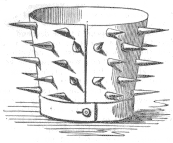This actually came as a shock to me while I was searching through the vast list of The Victorian Dictionary website and spotted the headline: Death & Dying. From the previous blog post, I read about the overcrowded state that London was in during the Victorian Era due to the migration of citizens from all over England settling down in the modernizing, vast city. Frankly, I did not even think about what happened past all of the disease that would be transferred from close living quarters of people, especially in the impoverished districts of London. Let alone the devious nature surrounding burials that churches were trying to shove under the carpets.
Death was, and still is, a rather expensive investment. Only the rich could afford a singular plot of land for a grave and a headstone out in the spacious countryside, “Wealth in London helps a man after death” (Bartlett 94). Rather than providing proper burials to those living in the city of London the churches would provide mass burials down in the basements of the churches. Tens of thousands of bodies lying to rot beneath the feet of worshipers. The church collected the money from grieving families, carted the bodies to the cellars, and collected donations from the worshipers whom contracted diseases from the bodies beneath the floorboards.
Victorian London thus brought overcrowded to an entirely new level in body count surrounding the living and the dead. With disease on the rise and not much room left in the basements of these churches, disposal of the older corpses were deposited into the Thames until quicklime was rendered a more practical method of disposing of older corpses under the noses of the House of Commons. And with whatever land was accessible by plots surrounding the church, the ground was used for mass graves. Quite a horrific way of burying the dead in one of the most famous modernizing cities in the entire world. Yet, the church capitalizing on the deaths of those in the impoverished class expresses the corruption slithering around during the Victorian Era. The lack of heath and safety regulations regarding the burying of human remains during this time period was slim-to-none, and allowed for the actions of the Church to get away with robbing the people of their money and the deceased of a plot of land. And those who could not even afford buy a coffin, let alone bury the dead, could only leave the deceased within the homes with family members, to decompose for days on end (Sims 1883). The collaboration of these numerous factors (overcrowded living, corruption, and poverty) played a key role in the eruption of disease and the widespread death and miasma surrounding the city of London. A shocking yet intriguing section to happen upon in The Victorian Dictionary, and an absolutely horrifying time to live, and die, in the history of London.
___________________________
Works Cited:
Jackson, Lee. “Victorian London – Publications – Social Investigation/Journalism – London by Day and Night, by David W.Bartlett, 1852.” Dictionary of Victorian London. Web. 27 Aug. 2015.
—. “Victorian London – Publications – Social Investigation/Journalism – How the Poor Live, by George R. Sims, 1883.” Dictionary of Victorian London. Web. 27 Aug. 2015.

